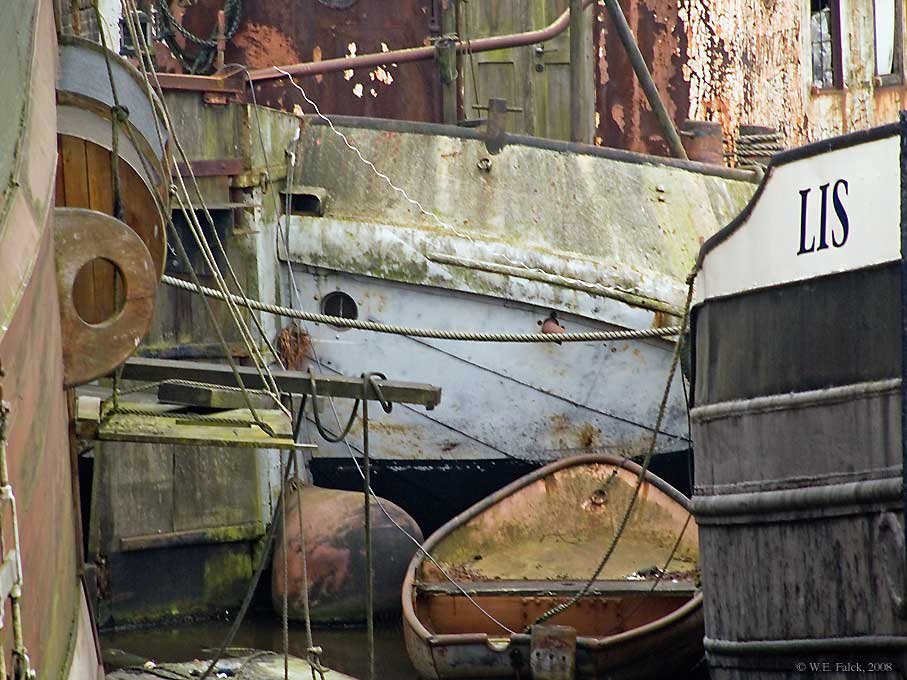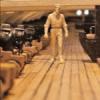Supplies of the Ship Modeler's Handbook are running out. Get your copy NOW before they are gone! Click on photo to order.
×
-
Posts
6,413 -
Joined
-
Last visited
Reputation Activity
-
 wefalck got a reaction from captainbob in When were blocks changed?
wefalck got a reaction from captainbob in When were blocks changed?
Are you guys talking of sheaves or really of the axles, i.e. the pins on which the sheaves run ? I have never heard that the axles were made from anything else, but metal. The friction of wood on wood would be rather to high and they would very quickly wear down without constant greasing.
I think there has never been a complete shift over from wood to metal as far as blocks for organic and man-made fibres is concerned. The sheaves of blocks for wire rigging to my knowledge have (almost) always been from cast iron. The wire rope would simply saw into wooden sheaves. Also, wire rope requires relatively large sheaves that would be quite expensive to make from wood.
wefalck
-
 wefalck got a reaction from robin b in Hammocks, cranes and covers
wefalck got a reaction from robin b in Hammocks, cranes and covers
Thomas Ender made various coloured pencil drawings on board of SMS AUSTRIA during the passage to Brazil. The main purpose of the voyage was to take the austrian prinzess Leopoldine there to become the wife of the brazilian Emporer. Ender's artistic legacy is preserved in the Kupferstichkabinett of the Viennese Academy of Fine Arts. I have several books on Ender, but only one plate shows another deck view of SMS AUSTRIA.
As to the accessibility of the shrouds, I seem to have seen that in some instances a sort of net with a mesh-width similar to the ratlines was installed on the inside of the bulwark reaching to the top deadeyes to facilitate climbing into the shrouds.
wefalck
-
 wefalck got a reaction from Jaxboat in MicroMark MicroMill - Review
wefalck got a reaction from Jaxboat in MicroMark MicroMill - Review
Sherline et al. call their mills because they are mills. As I said, it has nothing to do with spindle speeds, only with the geometric arrangement of the machine tool - and the design of the spindle: a drilling machine is designed for axial forces, a milling machine for radial forces and axial forces on the spindle. The table of (co-odinate) drilling machines may also not be designed for being moved under load, i.e. for milling, though using it for light milling might be ok.
wefalck
-
 wefalck got a reaction from WackoWolf in MicroMark MicroMill - Review
wefalck got a reaction from WackoWolf in MicroMark MicroMill - Review
Sherline et al. call their mills because they are mills. As I said, it has nothing to do with spindle speeds, only with the geometric arrangement of the machine tool - and the design of the spindle: a drilling machine is designed for axial forces, a milling machine for radial forces and axial forces on the spindle. The table of (co-odinate) drilling machines may also not be designed for being moved under load, i.e. for milling, though using it for light milling might be ok.
wefalck
-
 wefalck got a reaction from WackoWolf in MicroMark MicroMill - Review
wefalck got a reaction from WackoWolf in MicroMark MicroMill - Review
The spindle speed has to be a function of cutter diameter and material to be worked. For a cutter of say of 50 mm diameter and working steel, you would go down to a few hundred RPM. Conversely, with a small router in wood you need probably 10k or 20k RPM to achieve a clean cut.
wefalck
-
 wefalck got a reaction from trippwj in In need of shipyard workers or boats crewmembers
wefalck got a reaction from trippwj in In need of shipyard workers or boats crewmembers
There are litterarly thousands of 54 mm or 1:32 scale figurines in either white metal or plastic (hard or soft) on the market. One has to look a bit around other fora for this. They come in whole figures or also as separate arms, bodies, heads etc. Some imaginative surgery will be needed probably. The Tamiya plastic soldiers are 1:35 scale and visibly smaller and more delicate than the 1:32 scale figures and in comparison there is a much smaller range. The 54 mm scale market covers all ages and subjects.
The G-gauge has a scale of 1:22.5 BTW. I have never heard of any 1:29 scale.
wefalck
-
 wefalck got a reaction from EricWilliamMarshall in Micro Blocks
wefalck got a reaction from EricWilliamMarshall in Micro Blocks
Such drills can be purchased with either 1 mm or 1.5 mm shafts from jewellers and clockmakers supply houses, or with 2.35 mm shaft from some jewellers or from modellers supply houses. The smallest drills with 2.35 mm shaft though are 0.5 mm. The others go right down to 0.1 mm. These ground drills are pricey, but their concentricity is much better than the rolled ones where the shaft diameter = drill diameter.
You may also want to look out for carbide drills with a 2.35 mm shaft on ebay, which often come cheaply from the aerospace or printed circuit board industries. They are used and replaced as part of preventive maintenance, but still good enough for our purposes. They run very well, but are rather fragile, so ou have to use them in a drill press.
wefalck
-
 wefalck got a reaction from dafi in Tiny Thimbles
wefalck got a reaction from dafi in Tiny Thimbles
I have used slices of cored soldering tin in the past. The flux can be washed out with acetone and the soft material allows it to be 'forged' into the required shape.
However, for my current project that will be mainly rigged with 0,2 mm home-made rope (in 1/90 this translates to 18 mm diameter, which is a diameter that can be handled well under all weather conditions) these thimbles would be still too big. I think, I will be filling in the eye-splices with lacquer and then drill a hole through. They will be coloured by turning a sharp pencil in them, which gives a sort of metallic finish, looking as if they have been zinc-coated.
wefalck







.thumb.jpeg.fc5d633a7b34428fcf19419a73d56d55.jpeg)
